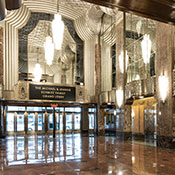
A Final Tune-Up
Paul Kosidowski
PUBLISHED
Tagged Under: 2021.22 Season, Bradley Symphony Center
Walk into any music venue—whether large or small—and you’re likely to see an array of microphones and cables crisscrossing the space, along with some headphone clad technicians sitting at mixing boards.
I certainly expected to see an array of equipment in Allen-Bradley Hall when I visited a recent Milwaukee Symphony Orchestra rehearsal. It was two weeks before the opening concert, and was attended by the acousticians from Akustiks, a Connecticut firm charged with making the hall sound as good as it looks.
But the only equipment Paul Scarbrough and Christopher Blair are planning to use to make the adjustments in the hall are the audio receivers that both have relied upon for their whole lives. Their ears.
The microphones and speaker arrays you see in many concert halls, Scarbrough explains, are used for recordings, and occasionally for non-symphonic groups that might play in the space. The sound the audience hears at an MSO concert depends only on the musicians and the design and physical configuration of the hall.
That’s why Scarbrough and Blair have been involved from the very beginning of the Bradley Symphony Center project.
“We laid out the key dimensions of the stage, the basic parameters and the shape of the canopy elements,” explains Scarbrough, referring to the walls and ceiling that surround the stage. “The architect then interpreted those basic dimensions and picked up on some of the historic architecture in the existing building.”
A key “parameter” involved one of the most challenging parts of the Symphony Center design and construction. “Paul convinced them that they have to move the rear stage wall back,” says Blair. Given the building’s status as a historic landmark, this meant sliding the entire 625-ton wall, 35 feet east to create a larger stage space for the orchestra.
“The acoustics team didn’t have to figure out how to do it,” laughs Blair, “but we asked for it.” And in August 2019, the wall was moved.
With the Bradley Symphony Center’s construction complete, Scarbrough and Blair have been here the past week to “tune” the hall using some of the architectural elements that have been built into the stage. They’ve been listening to the orchestra rehearse and making adjustments so that both the orchestra and the audience hear music that’s balanced, rich in detail, and clear.
Scarbrough likens the process to sitting at the eye doctor while he or she cycles through different lenses to find the right prescription: “You start with the large adjustments,” he says, “‘is this clearer, or this’ and work your way down to the finest detail.”
The large adjustments were made earlier in the week, primarily by changing the height and angle of the acoustic panels that hang above the stage. Today, the attention will be on the six large “windows”—actually mesh screens–that flank the stage. From the hall, they appear to be decorative—large, mullioned arches. But as Scarbrough explains as he shows me into a large room behind the left side of the stage, each screen masks a large door that can be opened or closed to let more or less sound into the backstage room. That, of course, means the more or less sound is being reflected back into the concert hall.
Letting some of the orchestra’s sound escape into a back room might seem like a bad thing, but it is part of the balancing process.
“You might think that you want every ounce of acoustic energy to get from the stage out into the audience,” explains Scarbrough. Blair jumps in to finish his thought: “If you provide that, nobody can hear anything. It’s just too much “early” energy. The sound that comes back to the orchestra from the hall—the ‘delayed’ sound—is what gives the orchestra the sense of whether it’s playing in tune. Or if the instruments are balanced. You really need the reverberation and feedback from the hall to make it work.”
That balance is necessary for both the players and the listeners. Throughout the tuning rehearsal, Blair sits on stage to hear what the musicians hear while Scarbrough sits in the audience. In between selections, the acoustics team talks to MSO Music Director Ken-David Masur and the orchestra members about what they are hearing onstage. At times, Masur and other musicians will wander into the audience while the orchestra plays. Later, they can also listen to recordings of the rehearsal made with a special stereo microphone positioned in the hall.
“It’s a constant process of talking with Ken-David and the musicians and getting feedback,” says Scarbrough. “When we make adjustments, are we moving in the right direction or the wrong direction?”
The real test, of course, comes that evening, when the orchestra plays for an invited audience—the first time it has played for a full audience in the new hall.
“When the audience will come in, the clarity will increase,” explains Scarbrough, “and we anticipate that. In an empty hall, it’s always a little on the mushy side.”
And the evening concert proves Scarbrough’s point. Playing a wide range of music for a nearly full house, Masur and the MSO fill the Allen-Bradley hall with music that is full of warmth, clarity, and full-blooded life.
The MSO Classics season opened October 1, and it features an array of fall concerts including the return of former Concertmaster Frank Almond, performing Bruch’s violin concerto. The Pops season opens October 29-31 with Prohibition, featuring music from the era that the Bradley Symphony Center first opened. Tickets to all concerts are now on sale at mso.org.



